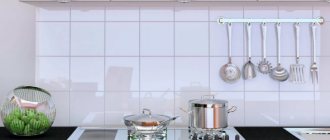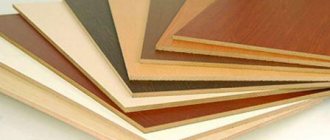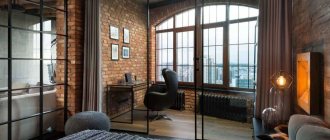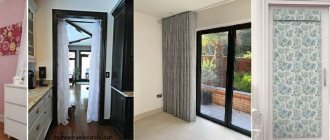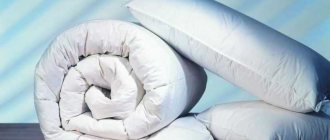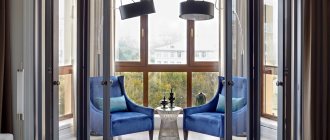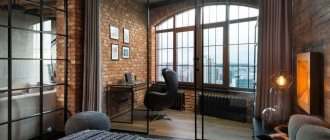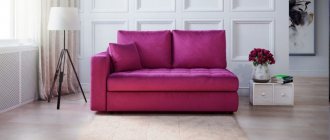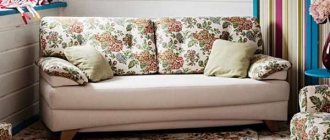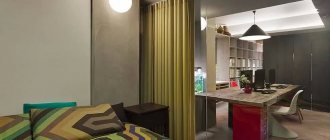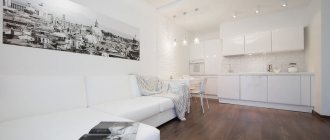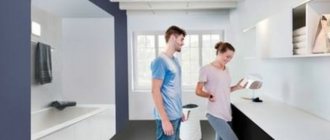Modern interior is a new approach to design, using only aesthetic design solutions. Relatively recently, a material such as PVC (polyvinyl chloride), a type of plastic, has become one of the leaders. Despite the dominance of white, many brands have long been producing options with increased decorativeness, color and texture. There is a demand for products with imitation of natural wood, stone, and brick. PVC has excellent technical characteristics. Resistance to negative influences has made polyvinyl chloride one of the most versatile materials. Panels are used to decorate technical and living spaces, walls and ceilings, interiors and facades. PVC cladding has virtually no weaknesses. Even from a renovation planning standpoint, plastic products outperformed other options. The key parameter of PVC panels is size. They determine the installation location.
Design and properties of PVC panels
The panels are based on two plates with a connection in the form of stiffeners. One of the surfaces is the front one and contains the corresponding decor. The structure of the panels was designed to be durable and at the same time neat and hidden. As a finishing material, PVC panels have undeniable advantages. They do not absorb moisture and are resistant to mold. Despite their high strength, PVC plates are flexible. This property prevents possible damage during transportation. The low weight of the skin ensures a minimal level of load on load-bearing surfaces. The color range, texture and parameters of the panels are wide enough to provide designers with options worth considering. PVC is an environmentally friendly material, which is also easy to process and install. At the same time, the panels will last for many years.
What to choose a PVC or MDF panel
Soft wall panels
When decorating walls or ceilings with panels, the question often arises of what types of panels to choose in order to complete the repair as quickly as possible, what they should be made of in order to have the best environmental properties, which panels are better than MDF or PVC. It is not possible to answer this question unequivocally, since each type of panel has its own number of advantages. Both PVC and MDF panels for interior wall decoration are simply ideal. Their fixation method is approximately the same. Repairs to the cladding of both walls and ceilings can be done with these materials yourself, without calling in specialists, this is a definite plus. During operation, the materials do not emit odor harmful to humans. The designs are very diverse, and both options are good in their own way. For example, MDF panels perfectly imitate wood structure, and PVC panels can be used to cover arched openings. At the same time, MDF panels are completely unsuitable for covering an arch, since they do not have the necessary properties to bend and cannot withstand a humid environment; in this case, their service life is reduced significantly. That is why, according to most consumers, panels based on polyvinyl chloride have the greatest positive aspects. But it is impossible to say unequivocally which is better and which type of PVC or MDF panels to choose without experiencing both options in action.
MDF panel
PVC panel
Advantages and disadvantages
PVC is an example of a material with a minimum number of disadvantages. This, however, does not mean that it will find application everywhere. Resistance to moisture is one of the key parameters for which PVC panels are valued. And due to the low price, these plastic products are available to almost everyone. The finished cladding can be disassembled at any time without the risk of damage. If access to some communications is required only occasionally, then the plates are installed directly on them.
Non-flammability is also included in the list of positive qualities. Contact with fire results in the release of dangerous compounds, but this drawback is present in almost all materials. In contrast to the external strength is the internal fragility of the structure. In a hollow plate structure with only stiffening ribs, sudden movement will cause damage, possibly serious damage. In addition, some options look too cheap.
If the choice is between PVC and classic materials (wood, metal, stone), then you should choose the first one - not least because of the variability in properties and appearance.
Criterias of choice
When purchasing PVC panels, you should pay attention to the cost of the product. The higher the price, the better the product
In order not to make a mistake in your choice and not to be deceived, it is worth familiarizing yourself with some aspects of the purchase.
The thickness of the panel is required. The universal thickness of vinyl for walls should not exceed 10 mm, and if you need to choose a building material for the ceiling, then you should pay attention to a thinner one. Front surface strength
This is important and necessary so that the building material can withstand damage and impacts, and at the same time there are no dents or scratches left on it. If stiffening ribs are visible from the outside, then it is better not to use such panels for lining walls. It is better to use them for ceilings, but such work will not look very good or of high quality. Number of ribs, their position and stiffness
The rigidity of a building material greatly depends on the number of ribs. The largest distance that can be between them should not exceed 10 mm.
- The uniformity of the paint covering the surface of the material indicates how the paint was applied to the panel. Most manufacturers coat the surface from the front side rather than adding color to the resin composition. This is bad because while working with the material, the paint can easily peel off the surface. Also, due to such a PVC coating, the panel may burn out, and the paint will be unevenly distributed, which is another disadvantage of such work by the manufacturer.
- When purchasing building material in a store, you need to inquire about its weight. This can help determine the stiffness of the ribs and the wall thickness of the material. The optimal weight of PVC panels should be 1.1–1.5 kg/sq.m. m.
- Are the panels firmly connected? It is better to check the strength of the connection of PVC panels when considering the product.
- What percentage of chalk does the material contain? Many professionals claim that the percentage of chalk in a product should not exceed 20%. If this percentage is higher, then there is a high probability that this material is quite fragile. Chalk is very accessible and not expensive, so some manufacturers, in order to reduce the cost of their products, add more of it than required by regulations. By bending the corner of the product, you can check the amount of chalk in it. If there is no white stripe left on the plastic, then the panel contains the required amount of chalk.
- Panels containing toxins. There is nothing wrong if the sealed lining has a characteristic, but not too pungent odor. But if a specific smell comes from the panels that are displayed as a sample, then it immediately becomes clear that this material contains toxic substances and it is better not to purchase it.
- Brand. If the product is from a reputable seller, then chances are good that the material is of fairly good quality. After all, in order to earn such fame, the manufacturer worked for a long time on the quality of its product, and values its reputation, therefore it offers only high-quality products for wall and floor use.
- Product decor. Facing panels must be heat transfer. They belong to economy class. Thanks to thermal printing, you can choose a variety of decor. The drawing is not afraid of exposure to ultraviolet radiation, and also does not wear off over time. Frieze options are in demand as they come in a variety of prints. Typically, such products imitate the surface of marble, tiles or natural wood.
Varieties and their sizes
Plastic panels are distinguished according to a number of criteria; in general, the following modifications should be distinguished:
- tiled;
- wall;
- leafy;
- lining;
- with 3d effect;
- thermal printing/thermal transfer;
- laminated.
The planks are intended for external or internal decoration. External options have less variation in terms of size. Interior materials are more decorative, while wall materials have a wide choice in terms of sizes. Conventional plastic lining has fixed dimensions. For the option with seams, the typical width is 10 cm and the thickness is 1 cm. Seamless modifications are usually used only as a material for improved layout. The width of seamless products is 10, 25 or 38 cm, and the length is 2.7 or 3 m, sometimes 6. Sheet panels have a more balanced length-to-width ratio, so it is convenient to assemble compositions from them. The same goes for tile panels. Their aspect ratio is usually 1:1, less often 3:2. Panels with drawings and original shapes have a small range of sizes. The width is usually 25 cm.
Which panels are better to choose?
The design of a bathroom made of plastic panels begins with their correct selection. Today there are many different types of PVC panels for the bathroom; they differ in shape and size, as well as in texture and method of fastening.
Based on their shape, there are 3 types of plastic panels:
Rack and pinion. In appearance they resemble ordinary lining. They come in different widths and are installed both on the frame and with glue. The slats are convenient for finishing bathrooms of non-standard shapes with various angles and protrusions. In addition, with their help you can visually raise ceilings (if installed vertically) or move walls apart (if installed horizontally). The width of standard products is in the range of 10-30 cm, height - 90-300 cm.
Tiled. A budget alternative to tiles has the same shape - a square. They often imitate mosaic, marble or concrete. The main advantage of this type is the integrity of the structure, which is achieved through special fastenings on the tiles. The sizes of the tiles vary from 10*10 cm, but 30*30, 100*100 cm are considered standard.
Leafy
The larger the material, the fewer joints, and this is important for the bathroom. After all, moisture penetrating into joints provokes the formation of fungus
In addition, even a large bathroom with large sheets can be renovated in just a few hours. The leaf width reaches 50 cm, and the length is 260-300 cm.
Conclusion: For bathroom design, decide on your priorities: visual correction of the room, absence of joints or speed of installation. This will tell you the ideal shape of the PVC panels.
By thickness they are distinguished:
- Up to 0.5 cm. This thin and fragile material is best used for ceiling decoration.
- 0.8-1 cm. Thick panels are more durable and suitable for wall decoration. In addition, they are protected from mechanical stress and fading in the sun.
Conclusion: For wall cladding in the bathroom, use planks 0.8-1 cm thick.
The photo shows a bathroom decorated with black plastic panels
PVC panels also differ in surface treatment technology and appearance:
- Offset printing. UV resistant, protected from moisture, scratches and other damage. Reinforced with a varnish coating.
- Thermal printing. There is no protective varnish coating, the design can be easily damaged and even erased.
- Lamination. Applying a film with a relief surface to the panel is considered the most durable option and has maximum resistance to damage.
Conclusion: It is recommended to use offset printing in the bathroom, and it is better to install laminated slats around the bathroom itself.
Another difference between PVC panels is the connection method.
- Seamless. Most often these are ceiling slats. They assume installation as close to each other as possible, the seam becomes almost invisible.
- Rustic. Otherwise - lamellas with a chamfer. They also interlock with each other, forming a single web. They decorate the walls and ceiling.
- Embossed. The uneven coating of the plastic panels masks the seam, making the space appear seamless. This is the most suitable option for walls, and it is also resistant to damage. But the cost of such finishing will increase significantly.
Conclusion: Decorate the walls in the bathroom with relief or rusticated panels.
There are 2 mounting methods:
- Frame. The slats are installed on a wooden or metal sheathing. The main advantage of the method is that there is no need to prepare the walls. In addition, you can hide communications in the frame - pipes, ventilation or wires. The disadvantages are the cost (the frame can be more expensive than the planks themselves) and a reduction in the bathroom area by 5-7 cm.
- Frameless. The panels are attached directly to the wall using glue, screws or staples. Suitable only for flat walls and makes it difficult to replace 1-2 slats if necessary. But at the same time it does not make the room smaller and allows you to save time and money on the frame.
Conclusion: Choose the installation method based on the size of your bathroom and the smoothness of the walls in it.
To summarize - when choosing PVC panels for a bathroom, first of all pay attention to the following nuances:
- thickness from 0.8 cm;
- offset printing or lamination;
- raised lamellas or chamfered;
- availability of an environmental safety certificate;
- number of stiffeners - the more, the better;
- serviceability of lock connections;
- quality of coating and correct joining of the pattern.
Tiled
This option is used not only in technical rooms such as the bathroom and kitchen. Tile panels of large sizes and non-standard shapes are purchased for the living room. Bathroom decoration most often consists of simple square products. In large bathrooms, the parameters reach 1x1 m - on the walls and ceiling. Modular options with many tenon joints are placed on the floor. It is better to clad small bathrooms with 10x10 cm panels with inclusions in the form of textural elements. Compositions in the form of mosaics are attached to the surface due to the connection between the elements and glue. Meter samples are often placed in kitchens, corridors, and terraces. The undeniable advantage of plastic lies in its external diversity. It is much easier to give this material an unusual shape than ceramics. As a result, any combination of ornaments, textures and colors become available.
Selection rules
In principle, all selection criteria have already been discussed. But there is another side to the issue - this is the decorative filling of the room where PVC panels will be used. The choice is actually huge, so it is very important to approach the problem of room design correctly. Therefore, several photos of PVC panels in different rooms:
Wall
Options for the wall with any form factor have a thickness from 6-8 to 12 mm. Seamless modifications have a length of 2.6, 2.7 or 3 m and a width of 15-50 cm. The length of standard panels is represented in a wide range - from one and a half to three meters. The longest options are purchased for offices. 6- and even 10-meter slats are made to order. Standardization applies to wall panels. In addition to unusual options, there are nine standard sizes on sale. For a width of 100 mm, there are length options of 2.7 and 3 m. The indicator of 175 mm corresponds to a 3-meter length. The 238 mm version comes with a length of 2.6 m. Panels with a width of 250 mm are 2.7 or 3 meters long. Products of 375 mm have the same compliance. Three-meter panels also come in increased width: 400 or 500 mm. Standard dimensions are also a width of 1035 mm with a length of 0.5 m, and 1220 mm with a length of 2.44 m.
Panel options
The parameters depend on the connection option and the type of PVC panel sizes.
Methods for connecting panels to each other are divided into three groups.
- Seam or slatted lamellas copy the lining, which is characterized by a similar connection. The seam is clearly visible and is part of the design. The panels are characterized by great rigidity and resistance to involuntary damage. They look like regular finishing boards. Standard size: width – from 12-30 cm, length – from 0.9-3 m, 6 m, thickness – 4-10 mm.
- Seamless are connected without a visible joint; when installed correctly, the result is a smooth surface with barely visible joints. The result of installation and assembly also depends on the quality of the material. Standard size: width – from 15-50 cm, length – 2.7 m, 3 m, thickness – 4-10 mm.
- Version with rustication. To connect this group, a decorative recess is made in the profile - a groove, which has the shape of a protrusion, resulting in a flat surface in relief.
Depending on the size, PVC panels come in several types.
Tiled
The tile material is similar to ceramic tiles. To create an unusual interior, when laying, you can combine plain options with slabs that imitate natural stone, have a pattern or are decorated with mosaics.
Standard size: 30x30 cm, 98x98 cm, 100x100 cm, thickness 1-5 mm.
Wall
Used to decorate walls. A variety of shades, textures, textures offer to make the interior of the house stylish and bright.
Standard size: width – 15-50 cm, length – 2.6/2.7/3 m; thickness – 6 -10 mm.
Leafy
They are large in size. When working with this type of panel, a significant area is covered - the design will be unusual and interesting.
Standard size: width – 50-122 cm, length – 0.9-2.44 m, thickness – 1-6 mm.
Leafy
Sheet panels are distinguished by a “knocked down” configuration. The sheets cover a lot of space at one time, making work much easier. Sheet products are suitable for implementing interesting design ideas. The length of the panels is in the range of 95-245 cm, and the width is 50-122 cm. The thickness is usually small - from 3 to 6 mm. The sheets are made thin to keep the mass of products within acceptable limits. However, some manufacturers make thick versions. Sheet elements are not only of the correct shape; on sale there is also a brick version with edges designed for folding parts into a puzzle. In addition to the brick pattern, imitations of wood, tiles, mosaics and slate are made. The most common parameters are dimensions 980×480, 980×498 and 955×480 mm. The optimal thickness for such sheets is 4 mm.
Features of PVC panels for ceilings: sizes and prices of products
Unlike wall products, ceiling panels are lightweight. Taking into account the fact that strength characteristics are not so important for ceiling decoration, manufacturers have focused on maximizing the lightness of the lamellas and creating a variety of design options.
Note! Finishing material for ceilings is more fragile. Maximum care should be taken during the cladding process.
To save money on the purchase of material, you should select panels taking into account the dimensional parameters of the room. In this case, it is desirable to achieve an optimal indicator in which after the installation procedure a minimum amount of construction waste (clippings) remains.
If the width of the ceiling base in the room is 2 m, then it would be most profitable to buy a PVC ceiling panel 4 meters long as a finishing unit. During installation, such panels are cut in half. Thus, the number of lamellas is doubled, which, after cutting, acquire a length of 2 m. The same can be done with 3-meter panels, provided that the width of the ceilings is 1.5 m.
Installation diagram of plastic ceiling panels
Before purchasing material, you should make a preliminary calculation of the required quantity. As an example, you can take a bathroom with parameters of 1.5x1.7 m. In this case, it is advisable to take PVC panels for a bathroom measuring 0.25x3 m. Taking into account the above, the slats will be cut in half.
The formula for calculating the cladding for a bathroom is: 1.7 m (length of the room) / 0.25 m (width of the lamella) x 0.5 (coefficient of cutting the lamellas in two) = 3.4 lamellas.
The result must be rounded to a whole number. In this case, it will be equal to 4. This is exactly how many PVC panels will be needed to cover the ceiling base in the bathroom.
Main types of PVC ceiling panels, sizes, prices
The standard thickness of ceiling panels is 8-10 mm. It is these parameters that formed the basis for the creation of moldings, which are selected taking into account the size of the lamellas.
Examples of finishing ceilings with plastic panels
Note! On sale you can find PVC ceiling trim with a thickness of 4-5 mm and even 12 mm. However, choosing suitable moldings in this case will be extremely difficult.
Types of moldings:
- F-shaped;
- ceiling plinth;
- connective;
- starting or edging;
- internal corner;
- external corner.
Fastening plastic ceiling tiles
Based on the type of construction, the following types of PVC ceiling slats are distinguished:
- “European” or eurolining – long panels with a wide locking system. Standard width 10 cm, length – 3 m.
- “Polka” - slats 3 m long and 10 cm wide with a narrow locking system.
- Reinforced lining - it is distinguished from standard panels by the presence of a double profile, as well as dimensional parameters. In this case, the width corresponds to 12.5 cm, and the length remains unchanged - 3 m.
- The slab is a square-shaped panel that does not have a locking system.
- Extended panels - the width of these elements is in the range of 15-50 cm, and the length can correspond to the following parameters - 2.6 m/2.7 m/3 m.
- Sheet panels are sheet material that does not have a locking system. The width of sheet elements can reach 0.8-2.03 m, their standard length is in the range of 1.5-4.05 m.
The lining can have several sections. On sale there are one-, two- and three-section products with different designs.
Prices for PVC ceiling panels:
| Name | Thickness, mm | Product size, mm | Price, rub./piece |
| White lining Economy | 8 | 100x3000 | 45 |
| White lining, single section | 10 | 100x3000 | 60 |
| Single-section colored lining | 10 | 100x3000 | 80 |
| White lining three-section | 10 | 240x3000 | 130 |
| Three-section colored lining | 10 | 240x3000 | 180 |
For economy lining, the cost of any of the moldings is on average 75 rubles/piece, for sectional ones - 85 rubles/piece.
Lining
PVC lining has the following size standards: length - 3-6 m, width - 100 mm and thickness - 10 mm. Products of standard size are used primarily for exterior finishing. To use them indoors, just cut them to length. Textures and patterns are applied to seamless lining. The material is seamless and generally has high aesthetic qualities. At the same time, for decoration, seams sometimes “turn” into a plus. Panels of seamless systems have standardized dimensions. Widths are 100, 250 and 380 mm. The indicators correspond to lengths of 2.7, 3 and 6 m. Thickness, as a rule, always remains at 10 mm. For ceiling cladding, wide lamellas are chosen, and for walls, on the contrary, narrow ones are chosen. Regardless of the size, the installation of the lining is carried out in the same way and in the same way for different situations. It is recommended to form a metal base, especially when it comes to seamless structures.
Panel material
The product of the modern chemical industry, polyvinyl chloride, belongs to organic polymers and contains only 3 main elements:
- Chlorine - 57%.
- Carbon - 42%.
- Hydrogen and various impurities, no more than 1%.
It should be noted that the absence of phenol-formaldehyde resin makes products made from polyvinyl chloride highly environmentally friendly and completely harmless to humans. Lightweight and durable material, white, has found its place in the manufacture of many consumer products. Including PVC panels for interior decoration.
Using various toners, manufacturers produce products in almost any shade. Any design can be easily applied to the smooth side of such products using industrial printing technology, for example, offset or thermal printing. Laminating the design makes it durable.
The specifics of large chemical production regulate the range of products by size. The standards provide for panels:
- In length, the most common values are 2700, 3000 or 6000 mm.
- In width, 100 and 250 mm. Recently, wide panels have begun to be used - 375 mm.
- The thickness varies from 1 to 30 mm. It all depends on the purpose of the product and the manufacturer.
With 3D effect
Products with 3D graphics decorate apartments, private houses, public places, office and shopping centers. Three-dimensional drawings can expand space, and are better than glass, mirrors and light shades. In addition to the print itself, the coating can simultaneously imitate stone, tile or wood. Clients have a wide choice of effects, and there should be no problems with the correct design of the room. Buyers are offered options with widths of 250, 370 and 500 mm. The length of the lamellas is 2.7 or 3 m, and the thickness is 8-10 mm. The possibilities of 3D design are not limited to drawings. The coating of products may contain large bulges - instead of a play of shadows and depth of color. Such plastic strips are also called 3D panels. Volumetric plastic coverings are much easier to install than options made from other materials. And their additional advantages are:
- design diversity;
- ease of care;
- favorable price-quality ratio.
Main types, sizes, prices and characteristics of PVC ceiling panels
From all of the above, we can conclude that PVC ceiling panels are a material of small thickness. For slabs and sheets – 4÷5 mm, for lining – 8 mm. This is due to the fact that the material on the ceiling will not be subjected to serious loads, which means there is no need to use thick and very durable models for cladding, which are more expensive than their wall counterparts. That is, the price, in turn, determines which category the plastic material you choose belongs to.
The sizes have been said, now regarding the prices of PVC panels for the ceiling:
| Photo | Model | Characteristics | Price, rub./panel |
| TECHNO | Dimensions: 0.25×3 m With photo printing, color, seamless. | 161 | |
| Lacquered white | Dimensions: 0.25×3 m, thickness 8 mm. | 168 | |
| Beige lotus | Dimensions: 0.25×2.7 m, thickness 8 mm. | 145 | |
| Kronoplast | Dimensions: 0.37×3 m, thickness 8 mm. Lacquered, white. | 205 | |
| Matte white | Dimensions: 0.25×2.7 m, thickness 8 mm. | 110 |
With thermal transfer or thermal printing
The manufacturing principle is to form a pattern or image on a polymer film and then apply temperature to transfer the pattern to a plastic panel. Actions are performed on special equipment. The process is called thermal transfer. The products have gained popularity due to their increased resistance to high temperatures and the thermal effects of steam, heat and direct sunlight. Assembling the system will not cause difficulties even for beginners. The dimensions of the material are given to standard values: 250 mm for width, 8-10 mm for thickness, 2.7, 3 or 6 m for length. Thermal printing makes it possible to apply highly complex designs on PVC panels in almost any color and shade. The technology works thanks to high temperatures and accurate calculations. The thickness is traditionally 8 mm, and the full parameters are, respectively, 300 × 25 × 0.8 or 270 × 25 × 0.8 cm.
Examples in the interior
Numerous room design samples allow you to quickly select the most suitable option. Today it is easy to find interesting options that will suit both the Provence style and the loft style. Very original design ideas can be realized using panels with photo printing.
The design of the hallway of a room with panels will be very interesting and bright. Moreover, you can choose bright PVC sheets with floral or abstract patterns that will look great against the background of wooden furniture. An excellent option for a spacious corridor would be panels with a picture, shaded with a not too catchy pattern. In this case, it is best to give preference to bright and rich shades to make the space seem lighter and more welcoming. For those who value elegance and modesty, wood-look panels will be an indispensable option for decorating the hallway.
It’s even easier to choose an interesting interior for the bathroom. Panels with a pattern similar to small mosaics or marble look ideal. They fill the bathroom space with a special charm. And you can give them a little pretentiousness by using moldings with gold and silver elements. Panels with 3D images of a marine theme can transform a familiar bathroom into a tropical oasis.
A kitchen area finished with cladding panels can look bright, practical and modern at the same time. For the main part of the walls (preferably the top), it is better to choose a color that is not too flashy, but the smaller part can be lined with panels with a bright pattern. In this case, the working part can be highlighted in a different color, conditionally dividing the kitchen into a zone. As for the choice of colors and shades, everything is entirely individual.
For more information about decorative PVC panels, see the following video.
Laminated products
The material is made by gluing a film with decoration and images onto the front side of the panels. Manipulation gives PVC planks improved performance properties. It will not be easy to spoil the design, and the plastic itself will receive some protection from mechanical stress. Laminated products are treated with an antistatic agent to prevent dust microparticles from accumulating on the surface of the images. The decorative film is covered with a transparent polymer film. The quality of the panels is confirmed by the appropriate certificate. In terms of dimensions, the thickness of the products is usually in the range of 8-12 mm, the length is either 2.7 or 3 m, and the width is 250 mm. Plastic panels are painted with special compounds. They hide natural imperfections in the form of minimal unevenness and smooth them out. The surface of laminated products can be either glossy or matte.
Technical characteristics of PVC panels
The service life of products for the conditions of our climatic region is more than 10 years. Currently, manufacturers offer products with different operating temperature ranges. Thus, some types of products allow use in the temperature range from – 30 to +80 ° C.
There are a variety of finishing options for the front plastic surface. The thermal printing method allows you to obtain many different images that are resistant to fading from sunlight, giving the cladding surface high decorative properties. The protective varnish coating makes the product resistant to abrasion, prevents scratches, and makes it easy to clean from dirt.
Calculation of the required material
Wall and ceiling panels have standardized parameters. For the first option, the following indicators are provided: length - 2.5-6 m, width - 250-300 mm, thickness - 6-12 mm. Narrow elements are easier to assemble. Ceiling strips have the following parameters: length - up to 10 m, width - 125-380 mm, thickness - 3-5 mm. The ceiling version may be smaller than the wall version, because the load on the ceiling is always less. Calculating the amount of material begins with measuring the perimeter of the base for the sheathing. The perimeter of windows and doors is subtracted from the result, and the resulting indicator is divided by the perimeter of one panel. Calculations are translated into determining area. The opposite sides of the room are summed up and multiplied by the height. The area of windows and doors is calculated only in one plane, multiplying the height by the width. The difference between the results obtained is divided by the area of one panel.
Calculating the material will not be difficult, but planning the original configuration will require special calculations.
Installation of wall panels
Plastic for walls can be installed on your own. This is one of the main advantages of this modern material, which allows you not to resort to the expensive services of professionals. In addition, it is important that no special auxiliary tools are required to install the panels on the walls.
The most common tools will come in handy:
- electric screwdriver or regular screwdriver;
- drill and drill bits for it;
- metal saw for cutting panels;
- knife;
- construction stapler;
- building level.
Installation of timber and metal profile sheathing
To install plastic strips on the wall, you need to make a sheathing. plastic panels will subsequently be fixed . A wooden beam with a cross section of 20–40 mm is suitable for these purposes.
To increase the service life and avoid adverse consequences, it is recommended to open the walls and wood with an antiseptic composition.
Suitable for fixing panels:
- self-tapping screws;
- nails;
- staples.
In addition to wooden beams, a metal profile (40 mm) can be used, onto which sheets of plasterboard are attached. The panels will only need to be attached to the profile with self-tapping screws. This method of fixing strips has one significant drawback - it takes up about 5 cm of usable area from each wall surface.
An excellent solution for mounting one plank to another is a clamp . This mount allows you to quickly attach one panel to another using a special groove and latch. Connecting panels in this way is no more difficult than putting together children's construction sets. And if the need arises for dismantling, then just press the clamp with a screwdriver, the latch will open, and the bar can be removed.
Each of the installation methods can be used when cladding residential premises, but in case of high humidity it is worth choosing plastic strips and plastic profiles. You can also use a galvanized drywall profile. It will last longer than wood, but less than a plastic profile.
Preparing the working wall and sheathing
The wall on which you plan to install plastic slats must be prepared. The surface is leveled and cracks are sealed. Next, be sure to prime the wall with antibacterial compounds and begin creating the sheathing.
Plastic panels can be attached to the wall in a horizontal or vertical position. Based on which direction of the planks is chosen, the sheathing will be fixed perpendicular to them.
Fixing plastic strips on the sheathing
The sheathing strips are mounted on the wall, maintaining a distance of 30–40 cm between them. If this step is taken more, the panels will begin to sag. In places such as a door or window opening, sheathing strips are installed along their entire perimeter. In addition, the slats are necessarily attached at the bottom, at the top of the room and very often at its corners.
When creating the sheathing, you must not forget to use a building level to create a base for a flat surface. Often, cushioning material is used to align the sheathing in one plane.
Perforated hangers or plastic mounting profiles are used according to the same principle.
And if wooden or perforated profiles can allow a slight deviation in relation to the geometric position of the panel strips, then plastic profiles should be mounted clearly perpendicular to the strips. Otherwise, it will simply not be possible to close the clamp.
When installing plastic strips, corner, F-shaped and starting profiles are additionally purchased. Such fittings will give a finished and neat look to the cladding as a whole.
The starting profile looks like a plastic strip of small width. It can easily be replaced at the ceiling level by a ceiling plinth that the owner likes.
After the sheathing is ready, the profiles are screwed to it. As a result, such a design should look like a frame into which the panels will be inserted one by one. A construction stapler is most often used to attach the frame.
Then take the first plastic strip and cut off the side tenon using a drywall knife. After taking the necessary measurements of the length of the panels, cut off the excess with a metal saw. The main thing during these actions is not to press too hard on the canvas, so as not to get a dent or crack. Having measured the required length of the panel, it is recommended to cut 4 mm more from the mark. This will allow you to insert the strip into the upper and lower profile without much effort.
With the side cut off, the panel is inserted into the corner profile, the upper and lower parts are placed in the ceiling and floor profiles and, lightly tapping with the palm of your hand, the plastic strip is driven into its original position.
After the first plastic lamella is in place, it needs to be fixed to the sheathing strip with a stapler or self-tapping screw (depending on the material of the sheathing).
After this, cut the second strip to the required length, insert it into the upper and lower profile and join it to the first strip. Fix it again with a stapler and begin installing the next strip.
This is how all plastic wall panels are gradually installed. The last plank before the corner can cause difficulty. It is cut to length and then adjusted to width. When the plank has the required dimensions, it will need to be inserted simultaneously into the adjacent panel and the side profile. As practice has shown, not everyone can do this without difficulty.
Experienced cladding makers advise doing the simpler thing and immediately placing the side profile on the last plank and only then connecting it to its “neighbor”. Professionals do not recommend doing this, but those who have suffered a fair amount of pain find this method very convenient.
There is another useful tip that will help you avoid using a corner profile. You can make a cut from the inside of the panel with a drywall knife. From the front side, the cut will not be visible, and the strip will be curved in the required position.
Tips and tricks for working with panels
It is better to install the planks using the efforts of two people, primarily when it comes to covering the ceiling or gluing baseboards. When drilling and cutting panels, you need to protect your eyes with special glasses. Cut the slats with a hacksaw or hand saw. Skirting boards are attached to plates using glue - one narrow strip is applied to the wall, the other to the finishing material. The nails in the panel are driven carefully and slowly, because the dents that form on the PVC cannot be leveled out. Installation of panels begins from the left corner of the room. The first step is to install the inner corner. The panels are mounted on the wall after installing the upper and lower plinths, since they need to be inserted into their connectors. Remove dirt and plaque from the finished coating only with a soap solution. Aggressive cleaning agents cause yellow discoloration over time.
A few more tips:
- The selection of the ideal size takes into account the parameters of the sockets: unsuccessful calculations will lead to falling out or the formation of bends.
- The surface without a frame should be pre-primed.
Installation of PVC panels on the ceiling
Once the frame is installed, you can begin installing the panels themselves. You need to start work from the outermost strip; it is attached to the corner, to the transverse material using self-tapping screws. So, the next panel will be installed in the groove of the previous one. This procedure should continue until the opposite wall is completely processed.
If necessary, the last panel can be cut, but only when it is not the right size. Since the material is fragile, it is prone to scratches, cracks or dents. Therefore, when working with panels, you should not press hard. It is recommended to take a utility knife and can also be used to move the panels in the desired direction.
After the last panel has been attached, you can begin installing the baseboard. It is secured using “liquid nails,” which are applied to the interior and attached to the ceiling. Afterwards you need to hold them for 10 seconds, and carefully remove the excess glue. “Liquid nails” dry quite quickly, so excess substances should be removed from the surface quickly.
Technology and installation methods
The planks are mounted using the tongue-and-groove principle with a contact depth that allows for quick assembly and disassembly of the covering. There are two main installation methods: on a frame (sheathing) and without it. In the first case, a metal base with rectangular openings is assembled. In the second case, such lathing is not needed; only approximately smooth walls and a base of glue or cement are enough. The disadvantage of this option is the difficulty of replacing individual elements. The ceiling is finished only using a frame method, and this is due to the possibility of hiding communications and placing recessed lighting fixtures, for example, spotlights, in some places. The material is glued to the walls to create the most durable surface. Plastic structures last longer if they do not bend from pressure at the edges. If the frame method is used, it is better to glue the plastic to pre-attached drywall.
Installation technology
As already noted, installation of PVC panels is so simple that you can do it yourself. To get started, you should stock up on the necessary tools:
- Screwdriver.
- An ordinary hacksaw.
- Scissors.
- Stationery knife.
- Roulette.
- Level.
- Square.
- Pencil.
In addition to the tool, you will need mounting elements :
- Self-tapping screws.
- Mounting profile. It is better to purchase a special one, but you can get by with a universal one - metal or wood.
Preparatory stage
Preparing the walls:
- We get rid of the old finish.
- Level the base. If the house is old and leveling to the required quality is difficult, then the defects can be corrected by lathing. This wastes a little space, but improperly secured panels can quickly become deformed and lose their appearance.
- The surface of the wall must be treated with an antiseptic. This will prevent the appearance of insects and fungus.
The position of the mounting frame is marked on the prepared wall. This work must be done carefully and always using a level. The frame begins to be mounted from below, rising to the ceiling. The lifting step is usually 500 mm.
Application areas of panels and beautiful examples
Plastic should not be used over the entire wall area if moisture exchange is of great importance in the room. For example, a mini-greenhouse with a dozen flowerpots will be spoiled by continuous finishing with PVC panels. But in places with rapid pollution and high humidity, you cannot do without a material like plastic. These include window slopes and separate rooms: bathroom, kitchen, hallway, balconies and loggias. The panels are in perfect harmony with plastic windows and doors. The ideal combination, however, can easily turn into excess if you arrange the interior thoughtlessly. But well-chosen panels will decorate the decor in almost any style direction. Buyers have a wide choice of textures and designs. If you have minimal design skills, it will not be difficult to qualitatively decorate a room in a space, marine or historical theme.
Bedroom
Silence and comfortable temperature are important for the bedroom. PVC panels will not only benefit the design, but also provide high-quality heat and sound insulation. From the headboard side, the bed can be decorated with original plastic panels. Options in white are suitable for a youth interior, for example, for decorating an alcove. Bedrooms in country wooden houses are decorated with lining to match the color of wood. Panels “under panels” are used as expensive cladding. The plates can also be combined with wallpaper, with color contrast or tone. The material is also suitable if the bedroom is planned in the spirit of minimalism with neutral tones or in a restrained version of the classic style. A room in the color of confectionery and in a marine theme with a predominance of blue and light blue is also a suitable environment for cladding with PVC lining.
Bathroom
In this part of the home, the panels will definitely not be superfluous. The color of the seams on the tile covering often deteriorates, and PVC finishing is a profitable alternative. PVC plastic is not only “not afraid” of moisture, but also does not deteriorate from temperature contrasts. In case of problems with the water supply or communications under the panels, the problem will be solved quickly, and the cladding will be restored just as quickly. For the bathroom, light colors are more advantageous. PVC plates make the color even deeper and enhance the visual expansion of space. Straight lines between the panels add expressiveness to the interior. In the bathroom, options with a wavy pattern or texture will be relevant. Traditional “wood-look” products, together with similarly designed sanitary ware, are a completely acceptable solution for bathrooms. The panels, in principle, go well with glass, metals and ceramics.
Optimal color solutions for the bathroom:
- blue and white;
- blue;
- green with white;
- green with pink;
- brown with white.
Kitchen
Like the bathroom, the kitchen “requires” design with moisture-resistant materials. The PVC coating will not interfere with wet cleaning. In combination with decorative properties, panels become the best option and are gradually replacing tiles from their dominant positions. The trend is also supported by the low cost and ease of installation of PVC sheathing. At the same time, the decorative properties are approximately on the same level as the tiled coating. Even an untrained person can assemble the panels. This is an additional saving. It is appropriate to use all types of coatings indoors: glossy, matte and satin. Drawings and photo printing will not worsen the situation. The apron is finished with skinali - a type of PVC panels. The space near the stove is decorated with LSU sheets. Heat-resistant options are selected for kitchens and these properties are the first thing asked about.
Living room
It is not customary to completely decorate a guest room with one material. PVC sheathing is combined with different types of coating. Modern style in the living room is realized with the help of spectacular transitions. For example, one of the walls is covered with clapboard, and the rest are “placed” in color contrast to it. In the living room, it is important to use panels “like” leather, brick, stone and wood. The 3D version of panels on the ceiling is an opportunity to significantly “increase” the height of the room. The same design methods are used on partitions, arches, columns and other elements of the halls. The panels perfectly emphasize horizontal niches, which are increasingly found in living rooms. Tile-shaped plates are used to form a special design, with connections at different angles, at different levels and with built-in lighting. In this case, the choice often falls on panels with natural or artificial wood patterns.
Advantages of using plastic panels
Plastic is a special material that does not rot, is not afraid of moisture and is quite easy to maintain. They can be used in almost any interior, from classic to loft style. The only place where they will not look appropriate is in the Empire, Rococo and Baroque styles, distinguished by their pomp.
The demand for PVC panels for walls is due to:
- High wear resistance of the material. They are not afraid of water, so they can be used for tiling a bathroom;
- Most models retain their original attractive appearance for a long period of time;
- Plastic is antistatic, so it accumulates less dust. Removing any type of contamination can be done without purchasing expensive specialized products;
- Plastic wall panels are much cheaper than covering walls with tiles or tiles.
Plastic is a special material that does not rot, is not afraid of moisture and is quite easy to maintain.
With proper installation, they can create sufficient noise insulation. Speaking about installation, it must be emphasized that they are attached quite quickly and do not require special skills.
It cannot be said that absolutely all material is harmless and that it will not release toxic substances into the air when heated. You can verify the safety of the product by asking for a quality certificate from the seller.
The wide range of colors and patterns is due to the fact that the material is easy to process. The panels perfectly mask all surface imperfections, including cracks and small differences. Behind them you can hide communication systems, for example, pipes, wires, cables.
Any plastic product has a specific smell, but with a quality product it goes away over time. In addition, do not forget that this is a combustible and flammable material.
When installing, you need to remember that such panels are afraid of sharp temperature fluctuations, as a result of which deformation of the structure occurs. They require careful preparation and surface treatment.
The panels perfectly mask all surface imperfections, including cracks and small differences.
